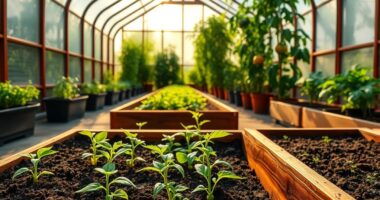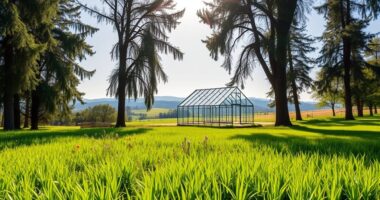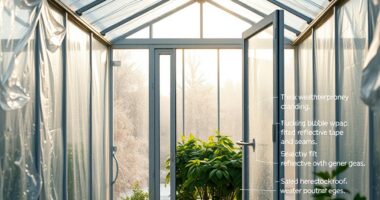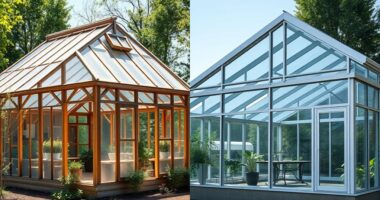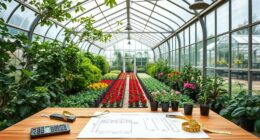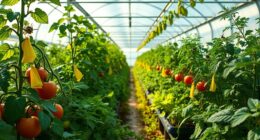Customizing your greenhouse design means you can shape it to fit your gardening style and needs. Consider material choices like galvanized steel for durability or PVC for budget-friendliness. Choose the right glazing for insulation, like double-pane glass or polycarbonate, to keep your plants comfortable. Don’t forget effective ventilation and climate control to promote healthy growth. You can also add interior features that enhance functionality and aesthetics. Discover more ways to optimize your greenhouse experience.
Key Takeaways
- Select materials like galvanized steel or polycarbonate for durability and insulation based on your climate and budget preferences.
- Choose glazing options such as double-pane glass or toughened safety glass for enhanced insulation and safety.
- Incorporate essential accessories like shelving systems and grow lights to optimize space and plant care within your greenhouse.
- Design the greenhouse to harmonize with your home’s architecture, using aesthetic materials that complement your garden landscape.
- Implement automated ventilation systems for effective climate control, ensuring a stable environment for plant growth.
Material Choices for Greenhouse Frames

When choosing the right material for your greenhouse frame, it’s essential to take into account factors like durability, cost, and environmental conditions.
Galvanized steel frames offer strength and rust resistance, making them ideal for larger structures but can be pricier.
Aluminum is lightweight and affordable, perfect for coastal areas, though it may lack insulation.
Wooden frames provide a natural aesthetic but require regular maintenance to prevent decay.
PVC frames are budget-friendly and easy to assemble, but they’re less durable over time.
Finally, composite frames blend materials for strength and low maintenance, suitable for various climates.
Consider these options carefully to find the best fit for your greenhouse needs. Additionally, selecting the right greenhouse material can significantly impact your overall gardening success.
Glazing and Insulation Options

Choosing the right frame is just the start; glazing and insulation play an essential role in your greenhouse’s efficiency and effectiveness.
You have several glazing options: horticultural glass is cost-effective but risky due to shattering, while toughened safety glass is safer.
Polycarbonate, available in twinwall and fivewall, offers excellent insulation and is nearly unbreakable.
Polycarbonate, with twinwall and fivewall options, provides outstanding insulation and exceptional durability for your greenhouse.
For insulation, consider double-pane glass for better R-Value or twinwall polycarbonate for more efficiency.
If you want the highest energy savings, choose fivewall polycarbonate.
Remember, laminated glass is also a safe option, remaining intact if broken.
Each choice affects light transmission and durability, so weigh your options carefully to create an ideal environment for your plants. Additionally, incorporating HEPA filters in your greenhouse can help maintain air quality by reducing allergens and pollutants that may affect plant health.
Effective Ventilation and Climate Control

To keep your greenhouse thriving, effective ventilation and climate control are key.
Automated ventilation systems can adjust airflow based on real-time conditions, ensuring your plants get the best environment.
Managing different climate zones within your greenhouse also helps maintain ideal temperatures and humidity levels for all your plants.
Automated Ventilation Systems
Automated ventilation systems are essential for maintaining the ideal environment in your greenhouse, guaranteeing that temperature and humidity levels stay within suitable ranges for plant health.
These systems help achieve key ventilation goals:
- Temperature Regulation: They prevent overheating, keeping conditions stable for your plants.
- Humidity Control: Automated systems reduce moisture-related issues, like fungal infections.
- Air Circulation: They guarantee even distribution of air, preventing stagnant areas that can harm plant growth.
With components like automatic vent openers, ventilation fans, and roof vents, you can customize your system to suit your greenhouse’s needs.
Combining passive and active ventilation strategies provides flexibility and efficiency, ultimately promoting healthier plants and reducing energy costs. Additionally, understanding greenhouse climate control is crucial for optimizing plant growth throughout the year.
Climate Zone Management
Effective climate zone management is essential for maximizing your greenhouse environment, especially since varying climate conditions can greatly impact plant health and growth.
In temperate zones, install heating systems for winter, while tropical climates need effective cooling and dehumidification strategies.
Proper ventilation is key; consider using natural airflow through vents or energy-efficient exhaust fans to maintain air circulation.
Make certain your greenhouse layout takes advantage of prevailing winds for ideal cooling.
Incorporate monitoring systems to track temperature and humidity levels, allowing you to make timely adjustments.
Additionally, selecting regional plant varieties will enhance growth outcomes.
Interior Features and Accessories

When designing your greenhouse, incorporating the right interior features and accessories can greatly enhance plant growth and overall functionality.
Consider these essential elements:
- Shelving Systems: Maximize your space and keep plants organized for easier access.
- Benches and Workstations: Create dedicated areas for potting and maintaining plants, improving your workflow.
- Lighting Solutions: Install grow lights to supplement natural light, especially during winter or in low-light conditions.
Don’t forget about ventilation and climate control accessories, like automatic vent openers and fans, to maintain ideal conditions.
A well-organized greenhouse, equipped with practical features, guarantees your plants thrive while making your gardening experience more efficient and enjoyable.
Aesthetic and Design Considerations

When designing your greenhouse, consider how it integrates with your home’s architectural style to create a cohesive look. Blending your greenhouse into the landscape not only enhances its beauty but also makes it a natural part of your garden. Choosing luxury materials can elevate the overall aesthetic, ensuring your greenhouse is both functional and visually appealing. Additionally, incorporating elements from your personal influences can further personalize the design and create a unique ambiance. It’s also beneficial to consider sustainable building practices to enhance the environmental impact of your greenhouse design. To achieve a seamless transition, you might incorporate similar flooring materials between your greenhouse and adjacent outdoor areas.
Architectural Style Integration
Integrating architectural styles into greenhouse design not only enhances aesthetic appeal but also creates harmonious spaces that blend with their surroundings.
By paying attention to architectural elegance and simplicity, you can create stunning greenhouses that serve multiple purposes.
Consider these essential elements:
- Light-filled Spaces: Use transparent materials to maximize natural light and improve indoor climates.
- Slender Constructions: Opt for lightweight designs that harmonize with urban environments, making your greenhouse feel less intrusive.
- Innovative Materials: Leverage advanced materials that emphasize sustainability while ensuring a seamless integration with existing architecture.
Landscape Blending Techniques
To create a harmonious greenhouse that seamlessly blends with your landscape, consider employing thoughtful landscape blending techniques that enhance both aesthetic appeal and functionality.
Start by designing pathways with materials like flagstones or gravel that match existing garden paths. Curved pathways can foster a sense of flow, while decorative elements like garden borders and lighting add charm.
Surround your greenhouse with native plants such as lavender or rosemary for natural integration, and think about using climbing plants like ivy to soften the exterior.
Incorporate functional features like seating areas and water elements to create inviting spaces. Additionally, using natural elements in your landscaping can promote tranquility and enhance the overall atmosphere.
Finally, guarantee the greenhouse’s color scheme and materials complement your garden, fostering a cohesive and serene environment.
Luxury Material Options
Choosing the right luxury materials for your greenhouse can greatly elevate its aesthetic and functional appeal. Here are three options to take into account:
- Glass: Though more expensive and fragile, it offers excellent light transmission, enhancing plant growth.
- Polycarbonate: Durable and cost-effective, it provides good insulation and a modern look without breaking the bank.
- Accoya Wood: This sustainably treated wood combines a classic appearance with enhanced durability, perfect for framing your greenhouse.
When selecting materials, ponder the balance between aesthetics and practicality.
Incorporating high-quality materials not only boosts your greenhouse’s visual charm but also guarantees better performance and longevity.
Make choices that reflect your style and meet your gardening needs.
Applications in Commercial and Institutional Settings

While commercial and institutional settings often require specific functionality, greenhouses can be tailored to meet diverse needs. You might consider passive solar design principles to maximize natural light and heat retention, ensuring energy efficiency.
High-performance glazing materials, like triple-wall polycarbonate, enhance durability and insulation. Efficient HVAC systems are essential for maintaining ideal growing conditions in larger operations.
Depending on your goals, you could choose from A-frame, Gothic arch, or gutter-connected designs to suit your climate and space requirements. Integrating automation systems and IoT technology can streamline processes, making tasks like irrigation and climate control easier.
Whether for research, education, or specialized crop production, custom greenhouses provide the flexibility and efficiency necessary for success in these settings.
Frequently Asked Questions
What Is the Average Lifespan of a Greenhouse?
The average lifespan of a greenhouse varies based on the materials you choose. For instance, polycarbonate can last anywhere from 3 to 20 years, while polyethylene film typically lasts around 4 years.
Glass, though heavier and requiring sturdier framing, can last indefinitely.
Factors like climate, maintenance, and material quality also play crucial roles in determining how long your greenhouse will effectively serve you.
Regular upkeep can greatly extend its lifespan.
How Do I Maintain My Greenhouse Year-Round?
To maintain your greenhouse year-round, clean the exterior twice a year and disinfect surfaces regularly to prevent pests and diseases.
Monitor temperature and humidity with thermometers and hygrometers, adjusting heating and cooling systems as needed.
Regularly inspect plants for pests, using beneficial insects and sticky traps for management.
Keep pathways clear for easy access, and plan your plant selections according to the seasons to guarantee a continuous harvest.
Can I Install a Greenhouse on a Sloped Yard?
Installing a greenhouse on a sloped yard can be a beautiful challenge. You can definitely make it work with some thoughtful planning.
Start by evaluating the slope and ensuring water drains away to avoid any unwanted surprises. Consider using retaining walls or adjustable foundations to create a stable base.
Embrace the slope’s benefits for sunlight and rainwater. With the right techniques, your greenhouse can thrive in its unique environment.
What Are the Costs Associated With Customizing a Greenhouse?
When you customize a greenhouse, costs can vary widely based on materials, size, and features.
Frame materials like wood or PVC range from $1.00 to $2.50 per square foot. Adding insulation, heating, or irrigation systems increases your budget, while DIY efforts can help save money.
Don’t forget about permits and maintenance, which can add another $100 to $600.
Ultimately, your design choices directly impact the overall expense.
Are There Any Local Regulations for Greenhouse Construction?
Isn’t it amusing how you can’t just plop a greenhouse anywhere you fancy?
Local regulations dictate where and how you can build your greenhouse. Zoning laws often restrict placement relative to property lines and may limit the number of structures allowed.
You’ll likely need permits, especially for larger builds.
Conclusion
As you step into your greenhouse, think of it as a canvas where nature paints its masterpiece. By carefully choosing materials, glazing, and accessories, you’re not just building a structure; you’re crafting a sanctuary for growth. Like a gardener tending to each seed, your attention to ventilation and design nurtures thriving plants. In this vibrant ecosystem, every decision you make blooms into success, transforming your vision into reality. Embrace the art of customization, and let your greenhouse flourish.


